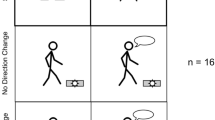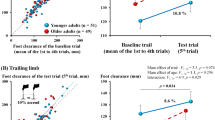Abstract
Lifting the limb sufficiently to clear an obstacle seems like a straightforward task, yet trips are a common cause of falls across all ages. Examination of obstacle contacts in the lab revealed a progressive decrease in foot elevation with repeated exposures, ultimately resulting in failure (Heijnen et al. Exp Brain Res 23:219–231, 2012). The purpose of this study was to determine if the progressive decrease in foot elevation continued when knowledge of obstacle contact was removed. Twenty-one young adults (mean 20.0 ± 1.0 years; 8 males) crossed a 20 cm obstacle in a 12 m walkway for 150 trials. The obstacle was covertly lowered between the lead and trail limb crossing of the obstacle, which eliminated obstacle contact with the trail limb if the limb was too low. The average failure rate was 8%, substantially higher than the 1–2% observed for stationary, visible obstacles. Therefore, tactile information from obstacle contact was instrumental for guiding the trail limb; visual information and joint angle information were insufficient for most participants. Foot elevation change over successive trials varied across participants, and was categorized as (1) asymptotic decrease (N = 11, 52%), with foot elevation converging to obstacle height, (2) linear decrease (N = 7, 33%), and (3) stable (N = 3, 14%). The asymptotic and stable groups appeared to have reasonable knowledge of obstacle height; the linear group did not. The asymptotic behavior is consistent with participants exploring the region above the obstacle through trial-and-error to determine appropriate foot elevation.


Similar content being viewed by others
References
Alexander MS, Flodin BW, Marigold DS (2011) Prism adaptation and generalization during visually guided locomotor tasks. J Neurophysiol 106:860–871. https://doi.org/10.1152/jn.01040.2010
Ambike S, Zatsiorsky VM, Latash ML (2015) Processes underlying unintentional finger-force changes in the absence of visual feedback. Exp Brain Res 233:711–721
Berard JR, Vallis LA (2006) Characteristics of single and double obstacle avoidance strategies: a comparison between adults and children. Exp Brain Res 175:21–31
Berg WP, Alessio HM, Mills EM, Tong C (1997) Circumstances and consequences of falls in independent community-dwelling older adults. Age Ageing 26:261–268
Chou LS, Draganich LF (1998) Placing the trailing foot closer to an obstacle reduces flexion of the hip, knee, and ankle to increase the risk of tripping. J Biomech 31:685–691
Corporaal SH, Swinnen SP, Duysens J, Bruijn SM (2016) Slow maturation of planning in obstacle avoidance in humans. J Neurophysiol 115:404–412
Corrigan JP, Cashman WF, Brady MP (1992) Proprioception in the cruciate deficient knee. Bone Joint J 74:247–250
Drew T, Andujar J-E, Lajoie K, Yakovenko S (2008) Cortical mechanisms involved in visuomotor coordination during precision walking. Brain Res Rev 57:199–211
Eng JJ, Winter DA, Patla AE (1994) Strategies for recovery from a trip in early and late swing during human walking. Exp Brain Res 102:339–349
Heijnen MJH, Rietdyk S (2016) Falls in young adults: perceived causes and environmental factors assessed with a daily online survey. Hum Mov Sci 46:86–95
Heijnen MJH, Muir BC, Rietdyk S (2012) Factors leading to obstacle contact during adaptive locomotion. Exp Brain Res 223:219–231
Heijnen MJH, Romine NL, Stumpf DM, Rietdyk S (2014) Memory-guided obstacle crossing: more failures were observed for the trail limb versus lead limb. Exp Brain Res 232:2131–2142
Lajoie K, Andujar J-É, Pearson K, Drew T (2010) Neurons in area 5 of the posterior parietal cortex in the cat contribute to interlimb coordination during visually guided locomotion: a role in working memory. J Neurophysiol 103:2234–2254
Lajoie K, Bloomfield LW, Nelson FJ, Suh JJ, Marigold DS (2012) The contribution of vision, proprioception, and efference copy in storing a neural representation for guiding trail leg trajectory over an obstacle. J Neurophysiol 107:2283–2293
Latash ML (2010) Motor synergies and the equilibrium-point hypothesis. Mot Control 14:294–322
Loeb GE (2012) Optimal isn’t good enough. Biol Cybern 106:757–765
Loverro KL, Mueske NM, Hamel KA (2013) Location of minimum foot clearance on the shoe and with respect to the obstacle changes with locomotor task. J Biomech 46:1842–1850
McVea DA, Pearson KG (2006) Long-lasting memories of obstacles guide leg movements in the walking cat. J Neurosci 26:1175–1178. https://doi.org/10.1523/jneurosci.4458-05.2006
Milner A, Goodale M (1995) The visual brain in action. Oxford University Press, Oxford
Milner A, Dijkerman H, McIntosh R, Rossetti Y, Pisella L (2003) Delayed reaching and grasping in patients with optic ataxia. Prog Brain Res 142:225–242
Mohagheghi AA, Moraes R, Patla AE (2004) The effects of distant and on-line visual information on the control of approach phase and step over an obstacle during locomotion. Exp Brain Res 155:459–468. https://doi.org/10.1007/s00221-003-1751-7
Muir BC, Haddad JM, Heijnen MJH, Rietdyk S (2015) Proactive gait strategies to mitigate risk of obstacle contact are more prevalent with advancing age. Gait Posture 41:233–239
Patla AE (1991) Adaptability of human gait: implications for the control of locomotion. Elsevier, Amsterdam
Patla AE, Greig M (2006) Any way you look at it, successful obstacle negotiation needs visually guided on-line foot placement regulation during the approach phase. Neurosci Lett 397:110–114. https://doi.org/10.1016/j.neulet.2005.12.016
Patla AE, Vickers JN (1997) Where and when do we look as we approach and step over an obstacle in the travel path? NeuroReport 8:3661–3665
Pontecorvo SM, Heijnen MJH, Muir BC, Rietdyk S (2015) The relationship between gaze behavior and failure to cross a stationary, visible obstacle. In: International society of posture and gait research world congress, Seville, Spain
Rhea CK, Rietdyk S (2007) Visual exteroceptive information provided during obstacle crossing did not modify the lower limb trajectory. Neurosci Lett 418:60–65. https://doi.org/10.1016/j.neulet.2007.02.063
Rhea CK, Rietdyk S (2011) Influence of an unexpected perturbation on adaptive gait behavior. Gait Posture 34:439–441. https://doi.org/10.1016/j.gaitpost.2011.06.011
Rietdyk S, Rhea CK (2006) Control of adaptive locomotion: effect of visual obstruction and visual cues in the environment. Exp Brain Res 169:272–278. https://doi.org/10.1007/s00221-005-0345-y
Talbot LA, Musiol RJ, Witham EK, Metter EJ (2005) Falls in young, middle-aged and older community dwelling adults: perceived cause, environmental factors and injury. BMC Public Health 5:86
Thies S, Jones R, Kenney L, Howard D, Baker R (2011) Effects of ramp negotiation, paving type and shoe sole geometry on toe clearance in young adults. J Biomech 44:2679–2684
Vaillancourt DE, Russell DM (2002) Temporal capacity of short-term visuomotor memory in continuous force production. Exp Brain Res 145:275–285
Viera AJ, Garrett JM (2005) Understanding interobserver agreement: the kappa statistic. Fam Med 37:360–363
Whishaw IQ, Sacrey LA, Gorny B (2009) Hind limb stepping over obstacles in the horse guided by place-object memory. Behav Brain Res 198:372–379. https://doi.org/10.1016/j.bbr.2008.11.023
Winter DA (1991) Biomechanics and motor control of human gait: normal, elderly and pathological. University of Waterloo Press, Waterloo
Winter DA (2009) Biomechanics and motor control of human movement. Wiley, Hoboken
Wong C, Wong G, Pearson KG, Lomber SG (2016) Memory-guided stumbling correction in the hindlimb of quadrupeds relies on parietal area 5. Cereb Cortex, 1–13. https://doi.org/10.1093/cercor/bhw391
Wong C, Pearson KG, Lomber SG (2017) Contributions of Parietal Cortex to the Working Memory of an Obstacle Acquired Visually or Tactilely in the Locomoting Cat. Cereb Cortex, 1–16. https://doi.org/10.1093/cercor/bhx186
Author information
Authors and Affiliations
Corresponding author
Ethics declarations
Conflict of interest
The authors declare that they have no conflict of interest.
Ethical approval
All procedures performed in studies involving human participants were in accordance with the ethical standards of the institutional and/or national research committee and with the 1964 Helsinki declaration and its later amendments or comparable ethical standards.
Informed consent
Informed consent was obtained from all individual participants included in the study.
Rights and permissions
About this article
Cite this article
Heijnen, M.J.H., Rietdyk, S. Failures in adaptive locomotion: trial-and-error exploration to determine adequate foot elevation over obstacles. Exp Brain Res 236, 187–194 (2018). https://doi.org/10.1007/s00221-017-5117-y
Received:
Accepted:
Published:
Issue Date:
DOI: https://doi.org/10.1007/s00221-017-5117-y




